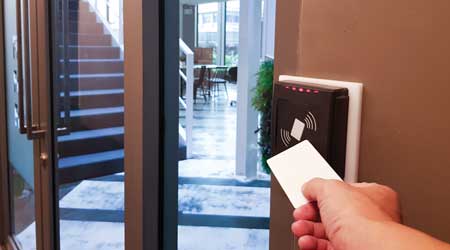New Touchless Door Technologies Gaining Momentum
The coronavirus pandemic has speeded the adoption of touchless and hands-free door and door hardware products.
The changing landscape inside and outside facilities has prompted manufacturers to offer a variety of solutions that allows users to operate a door either hands free or completely contact free, says Jay Vaitkus with Norton & Rixson. He adds that traditionally, two key drivers in managers’ decision around exterior and interior door hardware have been:
- code requirements, such as guidelines under the Americans with Disabilities Act and codes and standards from the National Fire Protection Agency
- application specifics, including level of use, user profile, security and energy efficiency.
Says Vaitkus, “Today’s focus on the reduction of germ transmission through frequently touched objects, especially doors and door hardware, throughout public and commercial buildings has driven demand for more hands-free and touchless door-opening solutions, raising the importance of this solution to be another key driver in the door-hardware purchasing decision.”
The interest among managers in minimizing the need for occupants to touch door hardware components actually is not new.
“The perceived need for healthy openings is an acceleration of a trend prior to the pandemic,” Durham. “The marketplace was already looking for healthier or touch-free solutions on high-traffic and riskier openings to mitigate the transmission of disease. Consumers and facility managers were already seeking solutions for restrooms and higher-risk openings associated with food preparation and healthcare applications.”
One major challenge in this environment is balancing this renewed interest with long-standing needs. Consider the challenges facing managers in retail facilities.
“Businesses are looking for ways to make their shopping environment secure, safe and healthy,” Durham says. “Reducing high-touch points decreases the amount of contact, which helps minimize germs. Managers are considering more than ever converting access points to touch-free. However, security is still top of the list, so the interior applications must meet the retailers security and code requirements, as well as safe and healthy needs.”
Balancing all of the issues is part of managers’ efforts to create an overall atmosphere of safety in their facilities.
“Retailers need to ensure the business feels safe and secure to both customers and employees,” Durham says. “Providing secure, touch-free hardware throughout the store promotes a safe and healthy environment, which exemplifies the retailer’s dedication to a healthy and secure environment. As facilities open back up, consumers and employees are more apt to return to a business faster if they feel that all efforts are being made to mitigate the spread of disease within a facility.”
Touchless tactics
As touchless options for door hardware expand, managers will need to spend more time evaluating their facilities’ specific needs, as well as the features and functions of door hardware options.
Says Vaitkus, “To lessen the spread of the coronavirus, the following factors have become high priorities in choosing hands-free and touchless door-opening solutions.”
- Single-person installation. “More job sites and facilities are placing severe limits on the number of trades people who can be on site at one time. Therefore, touchless solutions capable of being installed by a single person are preferred.”
- Key fob/remote function. “Solutions that enable users to operate a door to open and close limiting touchpoints is preferable, as is the ability for the user to close the door to create a barrier with other occupants and maintain acceptable social distance.”
- Infinite hold-open. “This is a great solution for doors that can remain open to allow for easy traffic flow with no need to touch the door.”
- Wave-to-open. “This operation to open the door without need to touch the wave switch is now in high demand, especially given the switch’s precision sensor that ensures operation when intended and prevents false opens.”
- WiFi setup. “This refers to modern door operators with a user-friendly graphic interface that can connect any smart, WiFi-enabled device – phone, laptop, tablet – to not only program the door operator but to make adjustments at any time without the need to climb ladders and remove an operator unit’s cover.”
- SuperScans. “These are devices that do not assist with the door-opening function but are intended to prevent the door from closing when a person or object is in the path of the door to prevent harm and reduce door touchpoints.”
Related Topics:














